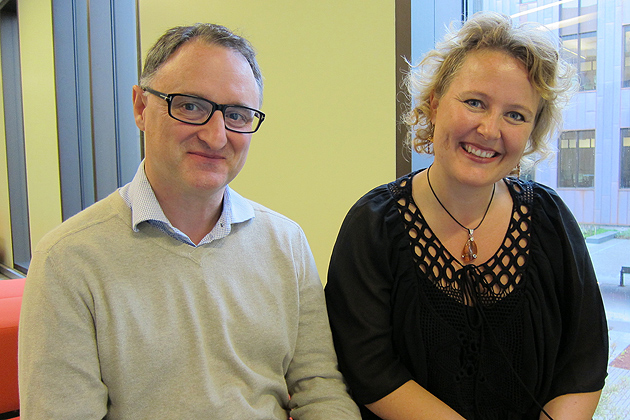
Think about your favorite professor or teacher.
Now, think about why you liked him or her. Did he explain things clearly? Was she animated and passionate about the subject material? Did you really love the course content?
Most of all, was he or she funny?
Manuela Wagner and Eduardo Urios-Aparisi, associate professors in the Department of Literatures, Cultures and Languages, are interested in how humor is used in teaching. Their studies involve not only how humor affects students’ learning, but how it can do so in the foreign language classroom.
“We’re interested in the differences in humor across languages, and also across cultures,” says Wagner. “We also want to know: How is humor being used as a pedagogical tool?”
Despite a wealth of studies on how humor is used in classrooms, the professors point out that little is known about the use of humor in language classes. Spontaneous humor is hard to study in the first place, says Wagner.
“It’s the intersection of a lot of disciplines – pedagogy, psychology, linguistics and languages,” she says. “Humor is a multifaceted subject.”
Classroom funnies
Like watching a comedic movie in another language with subtitles, humor in the language classroom could be perceived as not funny at all. So do language teachers attempt to be funny?
Wagner, who is from Austria, and Urios-Aparisi, who grew up in Spain, speak German and Spanish, respectively. They began collaborating when they received a 2005 Teachers for a New Era grant, and today their research focuses on how teachers use humor in middle-, high-school and college German and Spanish classes.
The researchers study humor in local classrooms by videotaping and observing students’ reactions. They developed a complex coding scheme that lets them study different facets of humor.
“If you like a teacher, you might be more eager to learn,” says Urios-Aparisi. Although, he points out, not all humor is endearing. For example, some people use humor to put other people down, which could have opposite consequences.
The professors’ research is ongoing, but their preliminary results show that humor may be used less often and with less variety in middle schools than in a college setting. Language teachers also vary widely in their use of humor – in some classes humor is the rule, but in others it’s the exception.
Wagner and Urios-Aparisi also applied their knowledge of language roles to a more consistent source of humor. Once they had developed their classroom coding scheme, they wanted to try it out on something more consistent, like a television show. Their choice? Sex and the City.
Scripted humor
Apart from language and cultural effects on humor, the researchers are interested in the prosody, or pitch and intonation of a person’s voice, used in humorous exchanges.
“When we use humor, do we mark it in any way? Does the way we speak make it apparent we’re trying to be humorous?” asks Wagner. Specific types of intonation and pauses in speech could be a signal that the speaker is trying to be funny, she says.
Because the show is scripted, the linguistic features would be easier to study and might be more pronounced than they are in everyday life, the researchers say.
So Wagner and Urios-Aparisi analyzed patterns of pitch used by the show’s four main characters: Carrie, Samantha, Miranda, and Charlotte.
They found that the character Miranda, whose personality is sarcastic and ironic, had the lowest pitch spectrum in her speech. Samantha, who is seen as dramatic and bold, used a wide spectrum of speech tones, speaking in high and low pitches in different instances. Carrie and Charlotte, often seen as the “straight” women in performance terms, had pitches somewhere in the middle.
Urios-Aparisi says that their findings reinforce the prototypes behind certain kinds of humor, like irony and exaggeration. Even though the show is scripted, people do tend to use specific types of humor roles in their lives, just as teachers might in a classroom.
Wagner speculates that they may have changed the game for the way women approach humor.
“It was so popular that it might have caused societal changes,” she says. “Traditionally it’s been taboo for young middle class women to talk about sex in public. Do women talk about these things more freely now?”
And their studies, they both admit, have made them a little more open to humor. Wagner says that since she started studying humor, she is less judgmental about some types of humor.
Urios-Aparisi, however, is a bit more subtle.
“I find a lot of things funny. I might not laugh, but I do think things are funny,” he says.



